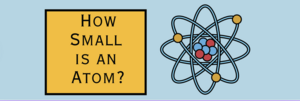You probably already know everything is made up of little tiny things called atoms or even that each atom is made up of even smaller particles called protons, neutrons, and electrons. And you’ve probably heard that atoms are small. But I bet you haven’t ever thought about how small atoms really are.
Spark your thinking!
1. Set up your Science mini spark recording page: #40: How Small is an Atom
2. Watch this TED-Ed video to learn more about the topic. Record 5 facts from the video.
3. The Kids Should See this webpage has created a lesson about the world’s smallest movie. Read this information and write 3-5 details on your recording page.
Magnifying carbon monoxide (CO) atoms to over 100 million times their actual size, arranging them into a series of 242 still images, and then animating them together, scientists at IBM Research have made the smallest movie ever. Wait, how small is that again?
“If an atom was the size of an orange, then the orange would be the size of the whole planet Earth.”

You will watch a a 60-second movie, “with a frame size of only 45 nanometres by 25 nanometres (45 x 25 billionths of a metre)”. It is called A Boy and His Atom. In 2013, it was Guinness World Records-verified to be the smallest stop-motion film in the world:
“Individual molecules of carbon monoxide were “placed” as pixels on a copper sheet to create each frame of the film. The molecules were positioned using a Scanning Tunnelling Microscope (STM), which uses an ultra-fine metal tip to move the molecules with electrical charge… Once the molecules of carbon monoxide were in place in each frame, the STM took 4 min 53 sec to scan the whole frame to build up the image recorded on film. This process was meticulously repeated for each frame.”
4. Watch the movie, A Boy and His Atom. On your recording page explain what makes this movie so unique.
5. Finish up this mini spark by watching the making of the the world smallest movie video. How did the scientists feel about the project? How did they get the atoms to move?
6. Share your science mini spark recording page with your teacher/EY coordinator.






 6. Share your Science Mini Spark Mini Spark recording page with your teacher or EY Coordinator.
6. Share your Science Mini Spark Mini Spark recording page with your teacher or EY Coordinator.



